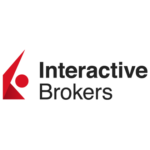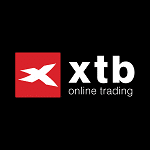NASDAQ trading platforms let you speculate on the Nasdaq 100 Index (ticker: NDX) an equity index comprised of the 100 largest companies listed on the Nasdaq market. We’ve compiled a list of some of the best NASDAQ brokers that are authorised and regulated by the FCA. We have personally tested each platform, interviewed the company CEOs, and compared costs, fees, market access, plus the different types of accounts for trading the NASDAQ.
City Index: NASDAQ trading signals and post-trade analysis
- Costs & spreads: 1
- Minimum deposit: £100
- Overnight financing: 2.5% +/- SOFR
- Account types: CFDs & spread betting
69% of retail investor accounts lose money when trading CFDs with this provider
Pepperstone: Automated NASDAQ trading on MT4
- Costs & spreads: 1
- Minimum deposit: £1
- Overnight financing: 2.9% +/- SOFR
- Account types: CFDs & spread betting
75.3% of retail investor accounts lose money when trading CFDs with this provider
Spreadex: NASDAQ trading with personal service
- Costs & spreads: 2
- Minimum deposit: £1
- Overnight financing: 3% +/- SOFR
- Account types: CFDs & spread betting
72% of retail investor accounts lose money when trading CFDs with this provider
Interactive Brokers: Discount NASDAQ trading & investing
- Costs & spreads: 0.005%
- Minimum deposit: $2,000
- Overnight financing: 1.5% +/- SOFR
- Account types: CFDs, DMA, futures & options
60% of retail investor accounts lose money when trading CFDs with this provider
CMC Markets: Best broker for NASDAQ CFD trading
- Costs & spreads: 1
- Minimum deposit: £1
- Overnight financing: 2.9% +/- SOFR
- Account types: CFDs & spread betting
74% of retail investor accounts lose money when trading CFDs with this provider
XTB: Good NASDAQ trading educational material
- Costs & spreads: 1
- Minimum deposit: £1
- Equity overnight financing: -0.02341% / -0.00159% DAILY
- Account types: CFDs
81% of retail investor accounts lose money when trading CFDs with this provider
Saxo Markets: Best broker for NASDAQ futures & ETF trading
- Costs & spreads: 1
- Minimum deposit: £500
- Overnight financing: 2.5% +/- SAXO RATE
- Account types: CFDs, futures & options
70% of retail investor accounts lose money when trading CFDs with this provider
eToro: Copy other people’s NASDAQ trading
- Costs & spreads: 2.4
- Minimum deposit: $50
- Overnight financing: 6.4% +/- SOFR
- Account types: CFDs
51% of retail investor accounts lose money when trading CFDs with this provider. You should consider whether you can afford to take the high risk of losing your money
Tickmill: NASDAQ futures on CQG or CFDs on MT4
- Costs & spreads: 1.93
- Minimum deposit: $100
- Overnight financing: na
- Account types: CFDs, futures & options
75% of retail investor accounts lose money when trading CFDs and spread bets with this provider
❓Methodology: We have chosen what we think are the best NASDAQ trading platforms based on:
- over 17,000 votes in our annual awards
- our own experiences testing the TECH100 trading platforms with real money
- an in-depth comparison of the features that make them stand out compared to alternatives.
- interviews with the NASDAQ brokers’ CEOs and senior management
Compare NASDAQ Brokers
| NASDAQ Broker | NASDAQ Trading Costs | Minimum Deposit | GMG Rating | More Info | Risk Warning |
|---|---|---|---|---|---|
 | 1 | £100 | See Platform | 69% of retail investor accounts lose money when trading CFDs with this provider | |
 | 1 | £1 | See Platform | 75.3% of retail investor accounts lose money when trading CFDs with this provider | |
 | 1 | £250 | See Platform | 69% of retail investor accounts lose money when trading CFDs and spread bets with this provider. | |
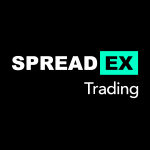 | 2 | £1 | See Platform | 64% of retail investor accounts lose money when trading CFDs with this provider | |
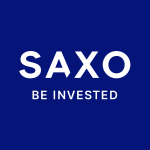 | 1 | £1 | See Platform | 64% of retail investor accounts lose money when trading CFDs with this provider | |
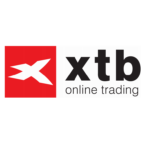 | 1 | £1 | See Platform | 77% of retail investor accounts lose money when trading CFDs with this provider | |
 | 1 | £1 | See Platform | 67% of retail investor accounts lose money when trading CFDs with this provider | |
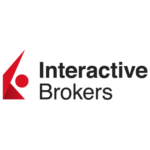 | 0.005% | $2,000 | See Platform | 62.5% of retail investor accounts lose money when trading CFDs with this provider | |
 | 2.4 | $50 | See Platform | 51% of retail investor accounts lose money when trading CFDs with this provider. You should consider whether you can afford to take the high risk of losing your money | |
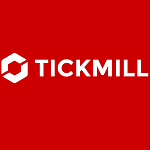 | 1.93 | $100 | See Platform | 71% of retail investor accounts lose money when trading CFDs and spread bets with this provider | |
 | 1 | £100 | See Platform | 68% of retail investor accounts lose money when trading CFDs with this provider. | |
 | 0.8 | £10 | See Platform | 66.95% of retail investor accounts lose money when trading CFDs with this provider |
How can you trade the Nasdaq 100 Index?
There are multiple financial products derived from the underlying Nasdaq 100 Index that you can trade with, including:
Read the GMG Guide on Index Trading.
The biggest ETF based on the Nasdaq 100 Index is the QQQ ETF (ticker: QQQ). For many years, this ETF is one of the most traded instruments in the US market. Investors like to gain exposure to the Nasdaq through this ETF.
Why is the NASDAQ so popular for trading?
Nasdaq Indices (100 and Composite) are the most-followed equity indices in the world. NDX is attractive to investors and traders alike because:
- Nasdaq 100 is a growth index – you can participate in the best success stories
- Nasdaq 100 offers good liquidity – some of the NDX components were the most valuable in the world at one time or another (Apple, Microsoft, and Amazon)
- Nasdaq 100 offers better relative performance than many other large-cap indices
Moreover, the Index is volatile enough to attract traders. Therefore, daily liquidity of the index is good.
NASDAQ versus the NYSE
To promote itself and beat its competitor, the New York Stock Exchange, Nasdaq charged lower listing fees. Smaller players who would like to list at an earlier stage became Nasdaq’s niche. Gradually, Nasdaq attracted plenty of growth companies via Initial Public Offerings (IPO). Apple Inc (AAPL) listed there in 1980; Microsoft (MSFT) in 1986. In total, Nasdaq currently has about 3,400 listing in its US markets.
What moves the Nasdaq 100 index price?
Stock markets are driven by a wide variety of factors, including some of the following:
- Macro factors (e.g. GDP, unemployment, business indicators etc)
- Monetary factors (e.g., Quantitative Easing, rates movements, yield curve etc)
- Technical factors (e.g., new highs)
For the Nasdaq 100, another factor to watch out for is speculative bubble.
During the nineties, for example, Nasdaq stocks soared amidst a wave of speculative trading interest. Companies worth only millions only a short while ago attained multi-billion valuation – only to see these valuation figures collapsed to zero when the bubble burst. Easy come, easy go.
Next, if you are trading NDX short term, you will need to pay attention to news flow and data announcements because they can have massive impact on the index over the short term.
Another area to watch out for are Federal Reserve meetings and the release of FOMC minutes. Any change in interest rates beyond market expectations can cause violent swings in the SPX. For example, if investors were expecting a 0.25% hike but the central bank raised it by 0.5% – this may cause prices swing massively after the announcement.
Studying the reaction of the market to these factors are important.
NASDAQ technical trading indicators
To trade the Nasdaq profitably requires a good trading strategy, of which technical indicators may come in handy. Technical indicators include:
- Trend indicators like moving average
- Price action
- Oscillators
- Support & resistance levels (see GMG Guide on Support/Resistance)
- Patterns like breakout and reversals
For example, you may use the moving averages to judge whether the index is still trending or due for a reaction.
Another favourite indicator is a break of resistance or support levels. Look at the Nasdaq 100 ETF (QQQ) below. It was clear that the breakout above the 195 key resistance last month resulted in a persistent rally into 204 (see below). This resistance, now broken, may even convert into resistance.
Bear in mind, however, the different traders will gravitate towards different trading styles. Therefore you must find the technical indicators that best support your trading objectives.
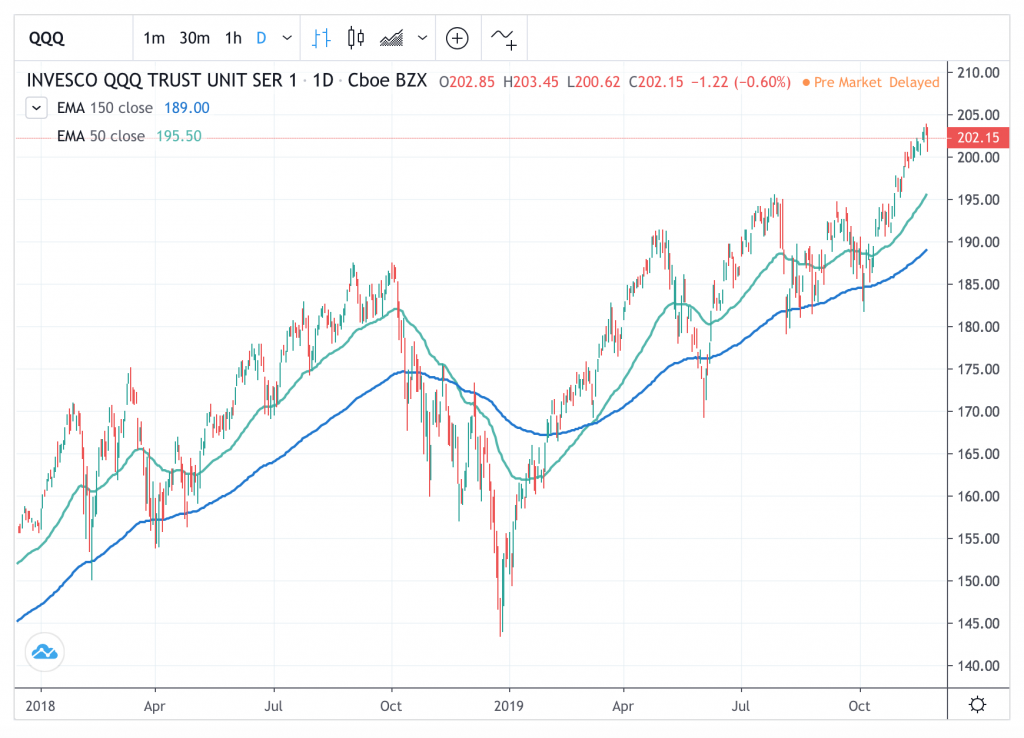
NASDAQ ETFs
Exchange-Traded Fund offers another way to trade tech stocks (read more about ETF here). Personally, I think this is a better way because it offers diversification instantly. In fact, many investors prefer trading ETFs to stocks because of their simplicity and liquidity. You may find is surprisingly that the most actively traded counter on Nasdaq is not a stock but PowerShares QQQ (QQQ) which tracks the Nasdaq 100 Index.
Alternatives to trading the NASDAQ
You can read about the major indices in our guide to the best indices for index trading.
⚠️ FCA Regulation
All online NASDAQ trading platforms that operate in the UK must be regulated by the FCA. The FCA is the Financial Conduct Authority and is responsible for ensuring that UK NASDAQ trading platforms are properly capitalised, treat customers fairly and have sufficient compliance systems in place. We only feature NASDAQ brokers that are regulated by the FCA, where your funds are protected by the FSCS.
NASDAQ trading FAQ:
Nasdaq stands for National Association of Securities Dealers Automatic Quotations.
Nasdaq 100 is capitalisation weighted; this means that companies with higher market capitalization carry a higher weightage in the index.
Apart from US firms, some foreign tech stocks also choose Nasdaq as their destination. Chinese tech firms like JD.com (JD), Baidu (BIDU), Netease (NTES) and PingDuoduo (PDD) are all listed there. You can gain exposure to the fast-growing China tech market via some of these stocks.
Apart from tech stocks, biotech firms are also worth looking at on the Nasdaq platform. Amgen (AMGN), Gilead Sciences (GILD) and Celgene (CELG) are just some of the biotech heavyweights listed on Nasdaq.
1971, Nasdaq has a longstanding history of hosting growth companies. It gained its popularity because Nasdaq was the first exchange to trade stocks electronically. At that time, it was a quantum leap in share trading.

Richard Berry
This article contains affiliate links which may earn us some form of income if you go on to open an account. However, if you would rather visit the NASDAQ brokers platforms via a non-affiliate link, you can view their US TECH 100 trading pages directly here:


